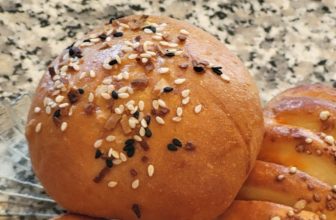
These Sourdough Pumpkin Dinner Rolls are made with soft, pillowy sourdough brioche dough, real pumpkin puree, and honey.
The pull-apart sourdough pumpkin dinner rolls are a perfect Thanksgiving side dish and another great way to add pumpkin and sourdough to the table.
They’re sweetened only with honey, topped with crunchy pumpkin seeds, and brushed with a honey butter glaze for natural sweetness and shine.
This detailed fall sourdough recipe walks through every step of the process and gives lots of tips and photos so you can get the best results possible.
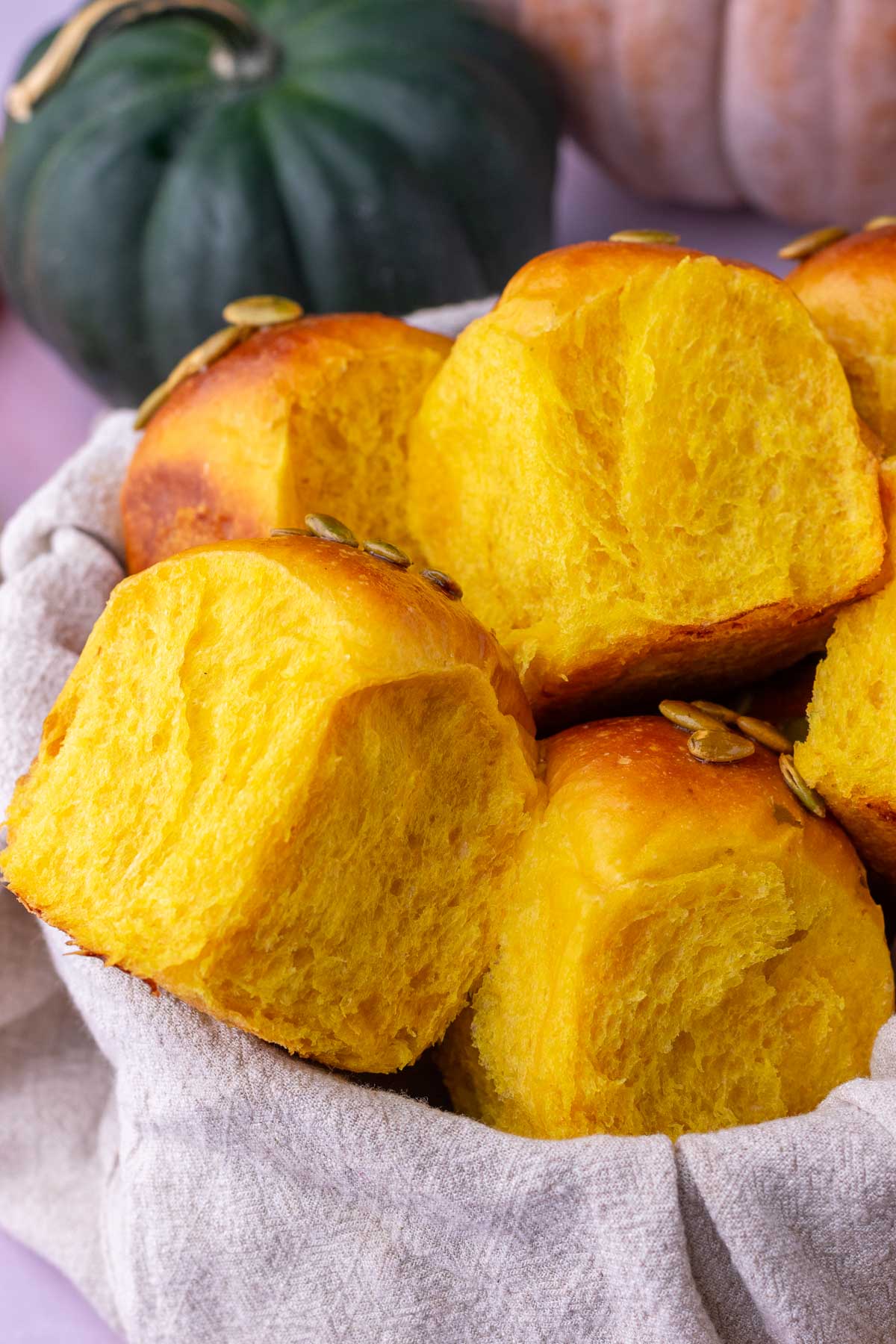
👍 Why You’ll Love This Recipe


👨🍳 Tips for Making the Best Sourdough Pumpkin Dinner Rolls
- Use room-temperature ingredients for easier mixing, including softened butter, as in these popular Sourdough Cinnamon Rolls.
- Proof the rolls until doubled in size, puffy, and feel full of air so they are light and fluffy.
- A trick for really soft dinner rolls is to scald the whole milk. This denatures the whey proteins in the milk, creating a more tender dough, as seen in my Sourdough English Muffins and Sourdough Hot Cross Buns with Brown Butter.
- Brush the rolls with honey butter glaze while they’re hot for a shiny, sweet crust.
- Let the rolls cool for 15 minutes in the pan, then transfer to a wire rack to cool completely, to prevent the bottoms and sides from getting soggy by circulating the air.


- Baking Scale
- Measuring your ingredients by weight rather than volume is essential for a more consistent, accurate bake.
- Stand Mixer with dough hook attachment (highly recommended)
- If you have a stand mixer, it’ll really help bring this enriched dough together better. This will help the dough build gluten more easily and quickly than by hand.
- If you don’t have a stand mixer, you can knead the dough by hand.
- 9×9″ Baking Pan
- This recipe makes 16 dinner rolls.
- If you want to double the recipe, you can bake the rolls in two 9″ square pans.
- Pastry Brush, for egg wash and honey butter glaze.
- Optional: Brød and Taylor Folding Bread Proofer
- This folding proofing box by Brød & Taylor is a game-changer to keep your sourdough starter and doughs at the perfect temperature while proofing.
- The proofer folds up easily, includes a humidity tray, is multifunctional, and can even be a slow cooker.
🛒 Ingredients Needed
See below for more information, variations, and possible substitutes.
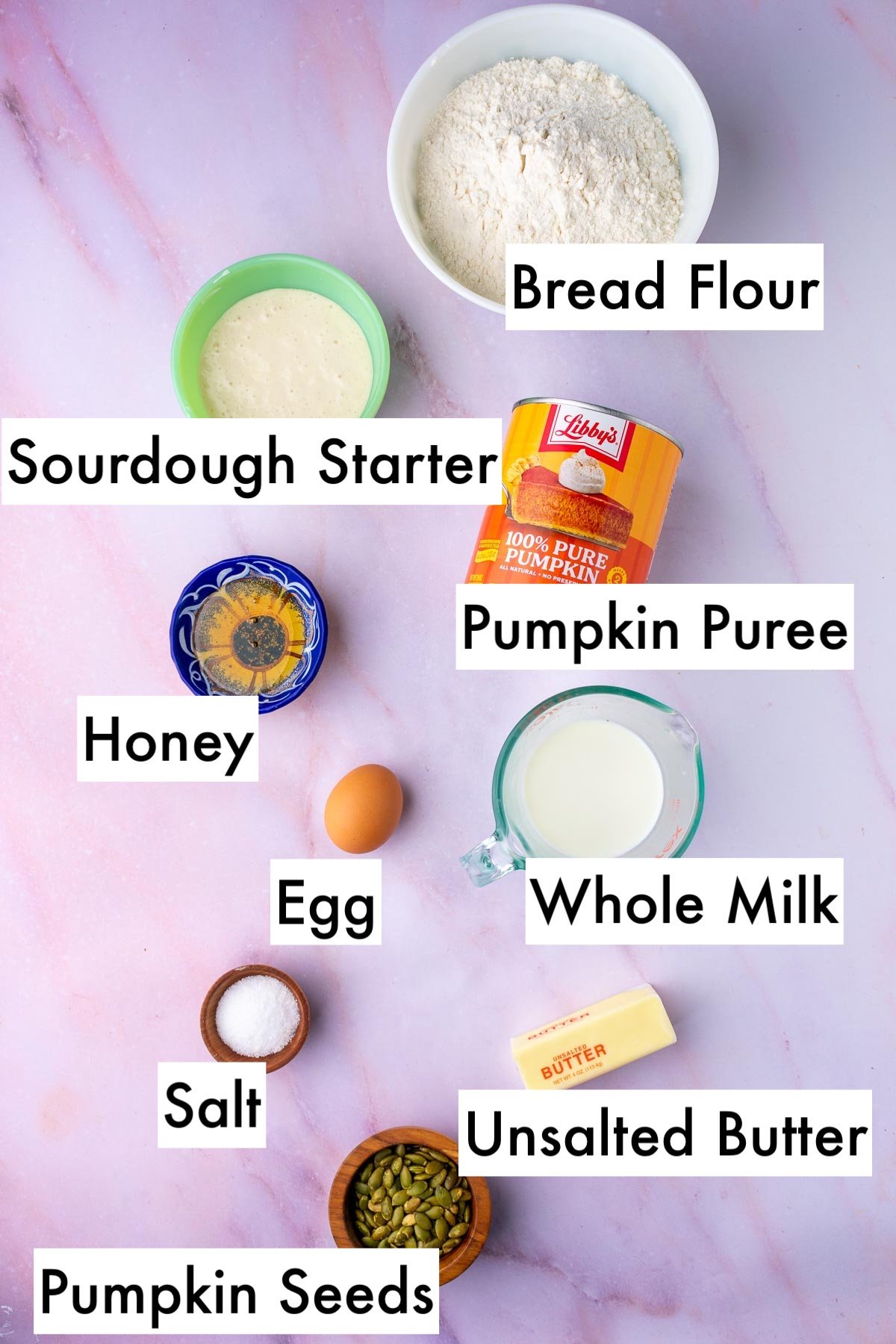

- Bread Flour
- I use King Arthur Bread Flour at 12.7% protein, which gives the pumpkin rolls a chewy texture and helps them rise tall. The higher gluten content is helpful when combined with canned pumpkin to add structure, but you can also use all-purpose flour.
- If you want to make it even heartier, substitute about 120g of whole wheat flour for a cup.
- Salt
- Sourdough Starter
- Canned Pumpkin Puree
- I recipe test with Libby’s canned pumpkin for consistency in my baking, but you can make your own pumpkin puree too.
- If you use a different canned pumpkin, the moisture content can vary.
- Unsalted butter, room temperature
- This is a brioche dough, so it’s vital that your butter is at room temperature so it will incorporate into the dough. If it’s too cold, it won’t mix well (or take forever to mix) and if it’s melted, it may make your dough too sticky.
- Brush the tops of the baked rolls with honey butter for shine.
- Egg, for richness, rise, and binding the ingredients. Plus, an egg is needed for the egg wash.
- Whole milk
- I always bake with whole milk and full-fat dairy for richness and the best flavor, but you can substitute the whole milk with 2%, low-fat milk, or plant-based if needed (use unsweetened).
- Scald the milk beforehand to denature the proteins, resulting in a softer bread, as I do for Sourdough Cinnamon Raisin English Muffins.
- Honey
- There’s natural sweetness in pumpkin, but a little honey pairs excellently with the rolls.
- You can substitute the honey with maple syrup, agave, or another natural liquid sweetener. You could also substitute the honey with granulated sugar or brown sugar.
- Pumpkin Seeds, for topping (optional)
- The pumpkin seeds are an optional topping, but they add a bit of crunch and color to the rolls.
- Leave off or substitute with sesame seeds, sunflower seeds, or add herbs such as sage, thyme, or rosemary.
🎃 How to Make Sourdough Pumpkin Dinner Rolls
Follow this visual step-by-step guide to help make these soft Sourdough Pumpkin Dinner Rolls.
1. Make the Levain
Mix 40 grams of sourdough starter, 40 grams of bread flour, and 40 grams of room-temperature water in a clean jar.
Cover and set it in a warm location (between 75-80ºF) for about 4-5 hours until it’s bubbly and ripe. The levain should double in size during this time.
Note: Alternatively, skip this step and use 120 grams of an active sourdough starter in the recipe.
To make a sourdough starter from scratch, follow my Sourdough Starter recipe.
Learn more about the difference between a starter and levain. If you’re an advanced baker, you could use a sweet stiff levain for this recipe and add a bit more milk to the dough when mixing.
2. Mix the Pumpkin Brioche Dough
Scald the whole milk in a small saucepan and set aside to cool until warm (not hot).
This will denature the proteins, resulting in softer dough. It’s a quick step that I do for many recipes like my Sourdough Maple Pecan Sticky Buns and makes a big difference.
Add the bread flour and salt to the bowl of a stand mixer fitted with a dough hook attachment and mix.
Then, add the cooled milk, levain (or active starter), pumpkin puree, honey, and egg. Mix on medium speed for about 5 minutes, until all the flour is hydrated and the dough comes together into a cohesive mass.
Continue mixing on medium speed, adding a small pat of softened butter at a time until incorporated. Wait until the butter is fully combined before adding the next piece.
Mix the dough for 10-15 minutes, or until it is smooth, tacky, slaps the sides of the bowl, and passes the windowpane test.
To test, pull a piece of dough between your fingers. If you can stretch it into a thin membrane, like a windowpane, without it tearing, then it’s mixed enough. Otherwise, keep mixing for a few more minutes.


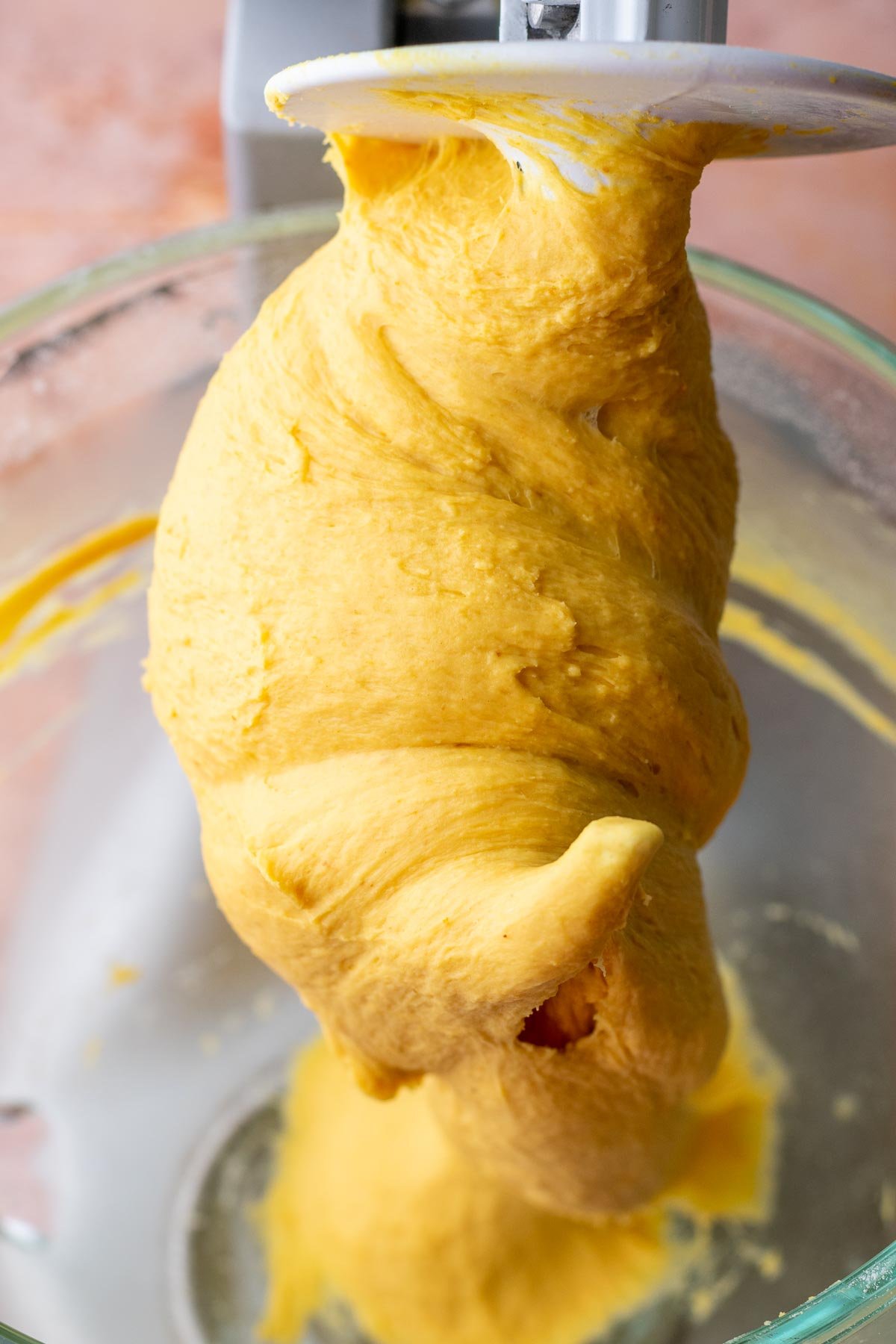

3. Bulk Fermentation
Transfer the dough to a mixing bowl and cover it for bulk fermentation, which will take approximately 6 hours at 78°F.
If your dough and environment are colder, bulk fermentation will take longer. Conversely, in warmer conditions, the dough will ferment faster.
Bulk fermentation is complete when this dough has doubled in size, is smoother, and domes in your bowl.


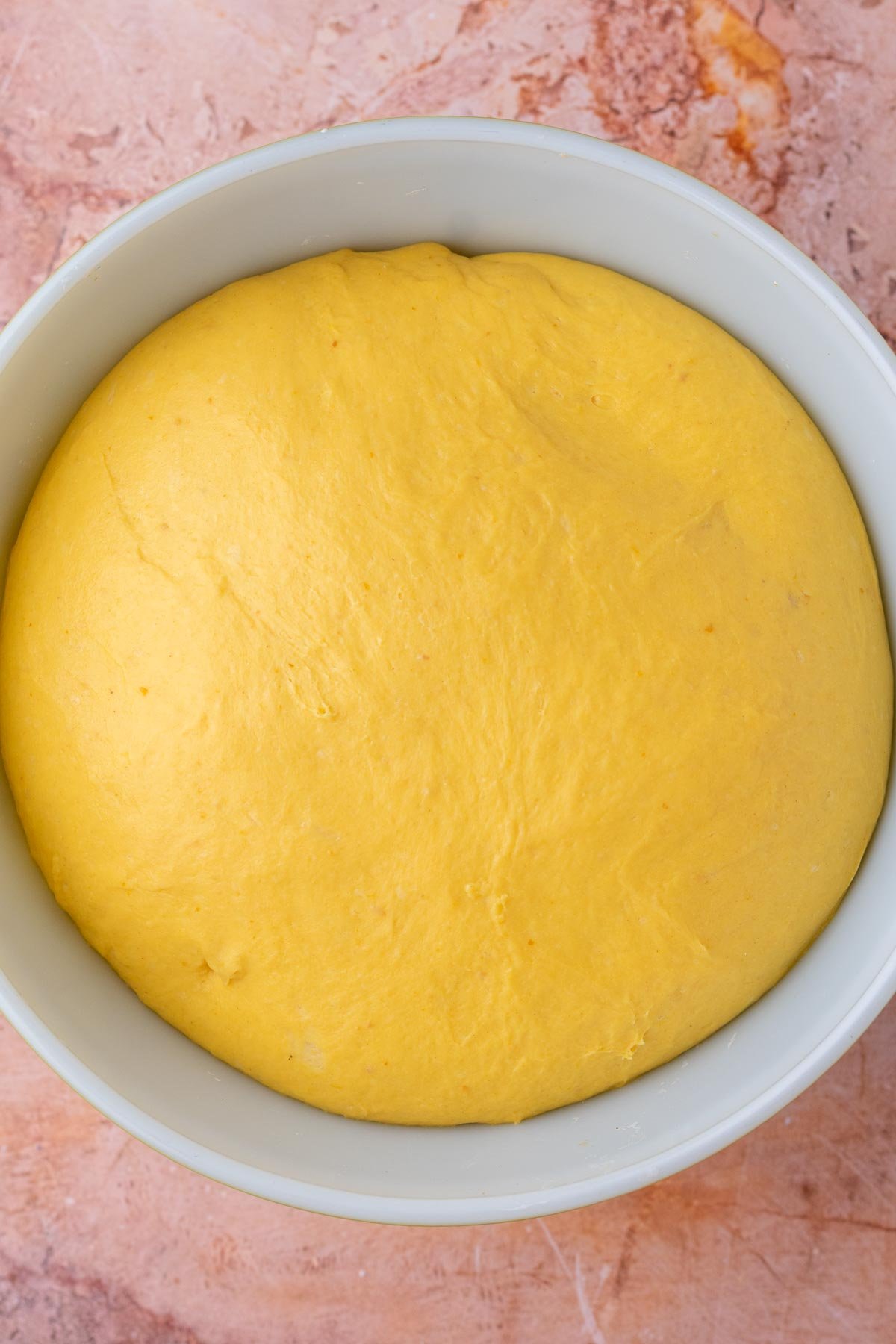

4. Overnight Proof
Transfer the dough to the refrigerator for a cold, overnight proof and up to 48 hours.
The dough will continue to ferment slowly in the refrigerator, which helps develop flavor and allows you to bake on your own schedule. The cold dough is also easier to divide and shape into rolls.
If you’re limited on time, you can skip the overnight proof.
5. Shape the Pumpkin Dinner Rolls
Before shaping, butter or grease the 9×9″ pan. Set it aside.
Punch down the cold dough, weigh it, and divide the dough weight by 16. This is how much each roll should weigh when you divide the dough. Mine usually weigh about 70g each.
Use a bench scraper to divide the dough into 16 pieces. Then, use the palm of your hand to shape and roll the dough into round spheres.


6. Final Proof
Place the shaped sourdough pumpkin dinner rolls in the pan and cover with plastic wrap or a lid for the final proof.
At 78ºF, the final proof typically takes about 3 ½-4 hours, but it depends on the ambient temperature and how much the dough proofed during the first bulk ferment.
At the end of the final proof, the rolls should double in size and rise in the pan, be puffy, touch each other, and feel full of air if you poke one with a floured finger.
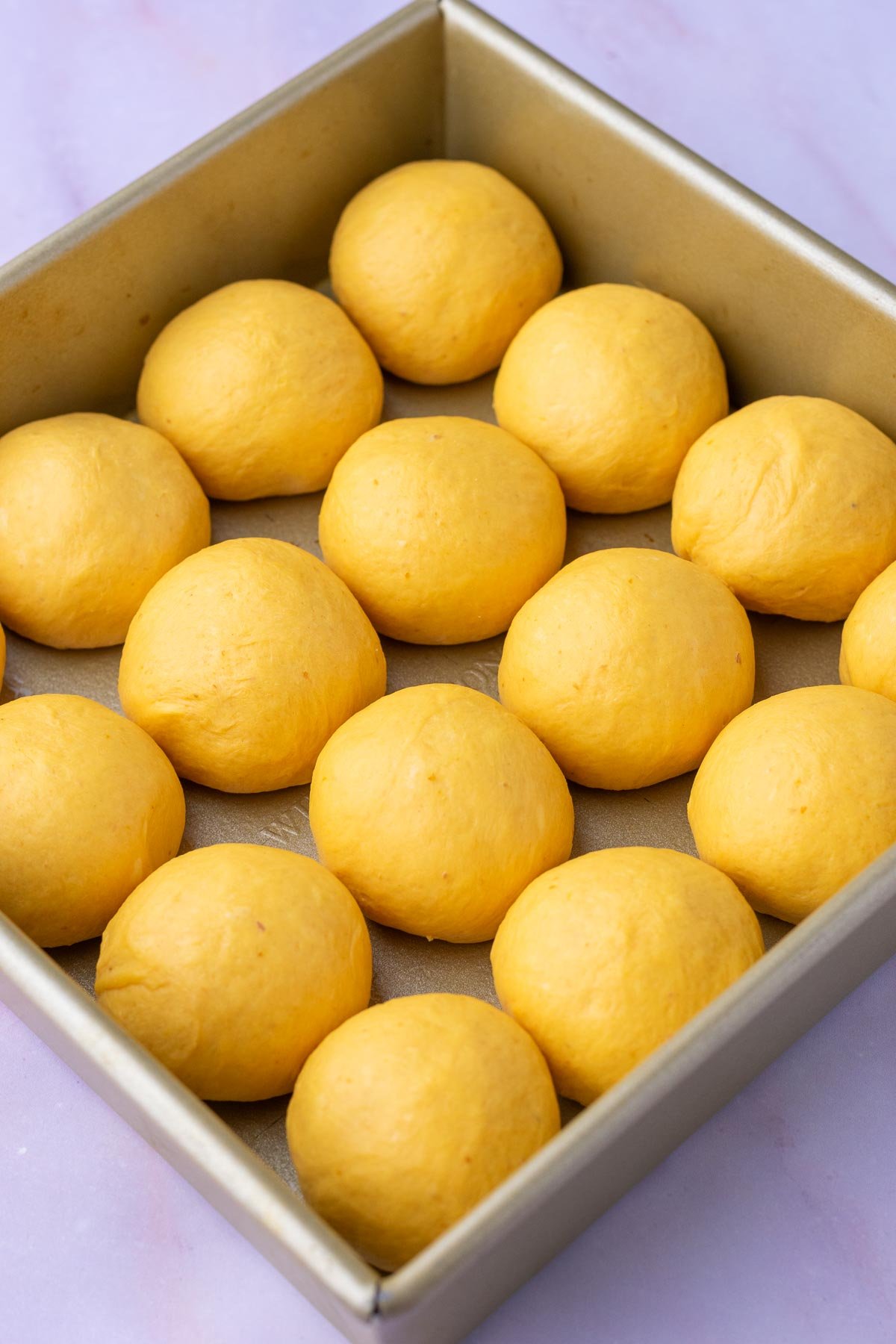

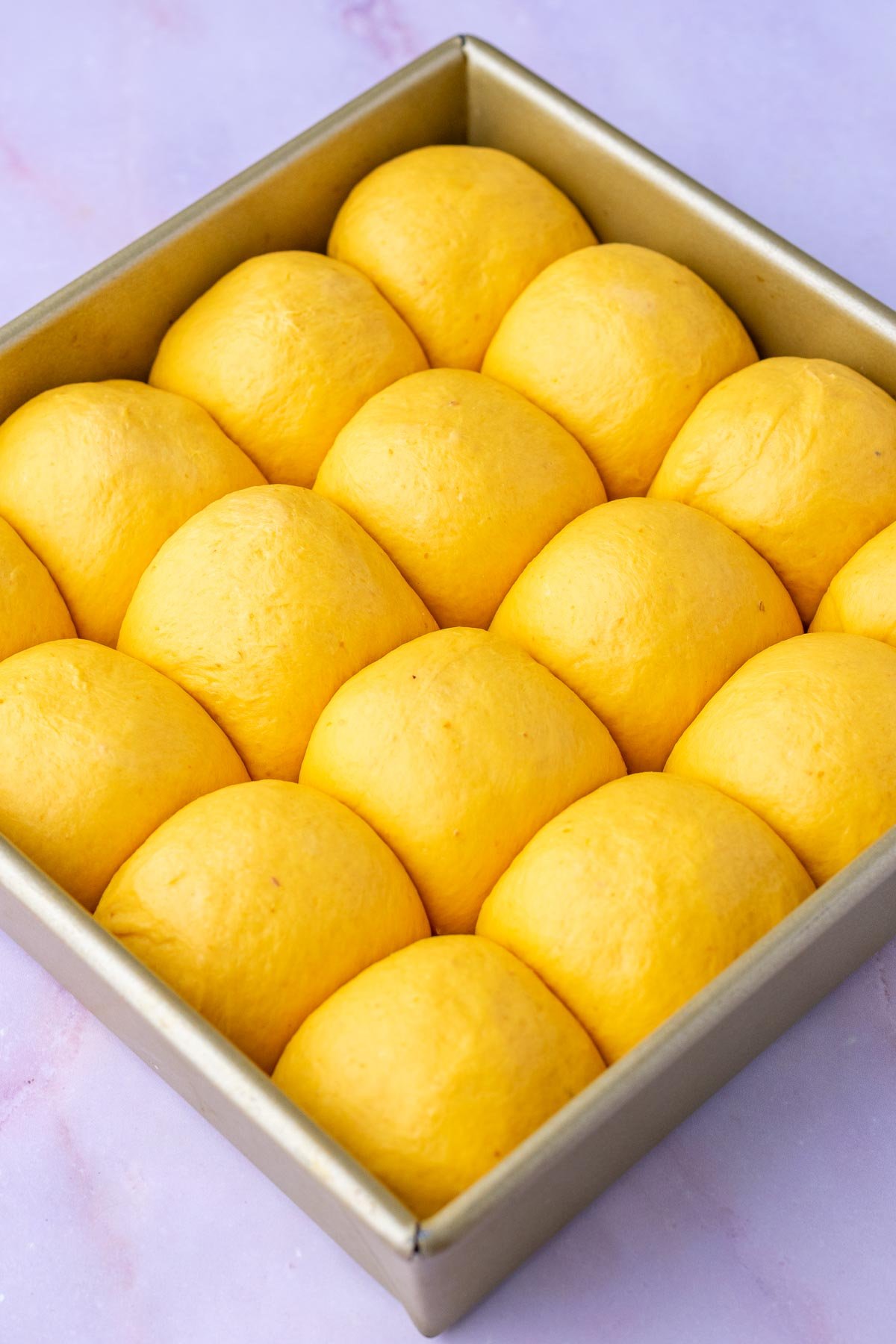

7. Bake
Preheat the oven to 375ºF (191ºC).
Brush the rolls with egg wash and sprinkle the tops with optional pumpkin seeds.
Bake the rolls for 25-28 minutes or until the tops are deep golden brown. The sourdough pumpkin dinner rolls should have an internal temperature of about 200ºF (93ºC) when baked, as measured with an instant-read thermometer.
As the dinner rolls bake, make the honey butter glaze. Brush the simple glaze onto the rolls as soon as they come out of the oven, while they’re still hot.
Finally, cool the rolls in the pan on a wire rack for 15 minutes. Then turn the roll out of the pan and finish cooling completely on the wire rack to prevent condensation from making soggy rolls.
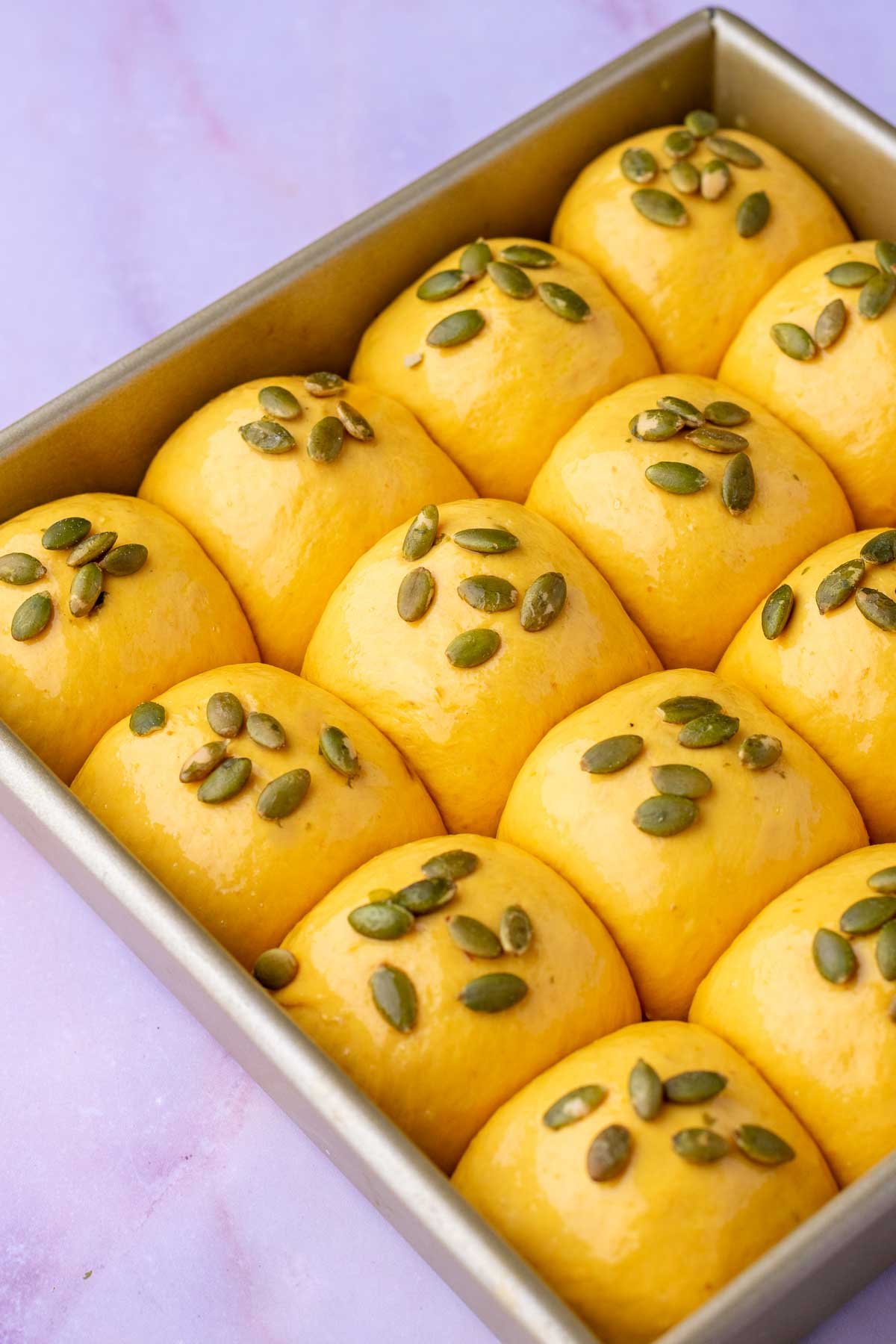





How to Store, Make Ahead, & Serve
The canned pumpkin and sourdough help keep these sourdough pumpkin dinner rolls soft for days so you can easily make ahead and store them.
Keep the baked rolls covered at room temperature for 3-4 days, or refrigerate for up to a week. They will lose some moisture over time and become more stale, but you can reheat or toast them slightly before serving.
To freeze baked dinner rolls, place them in a freezer-safe bag and store for a few months. Thaw overnight in the refrigerator and rewarm in the oven.
If you want to freeze unbaked rolls, do so after shaping. Then, let them thaw overnight in their pan in the refrigerator and do the final proof and bake as usual. This final proof can take longer the colder they are.
These dinner rolls are perfect for fall holiday dinners, Thanksgiving, Christmas, or to serve with hearty soups and stews.
I like serving them with more honey butter, maple butter, or creamy homemade Apple Butter.
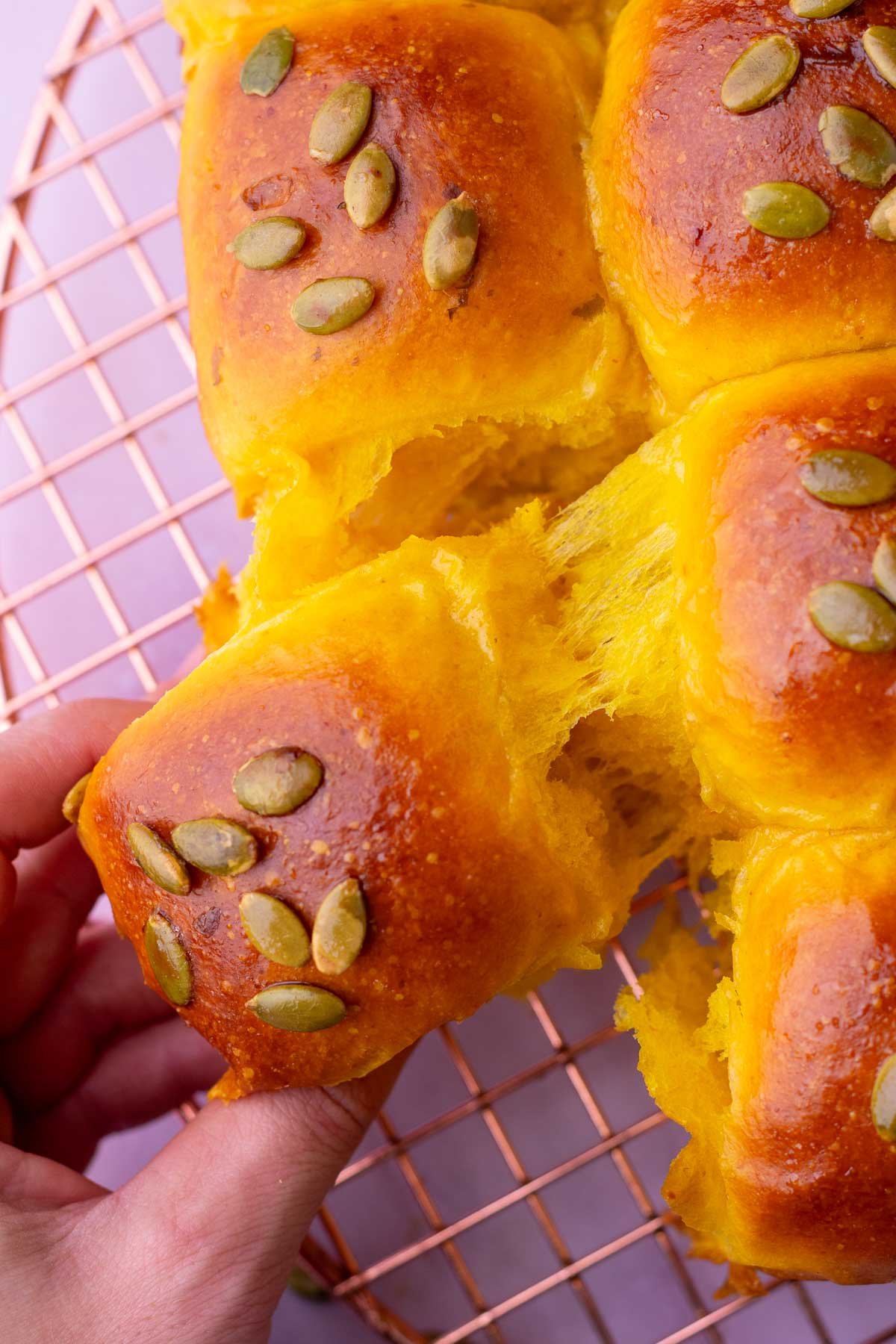

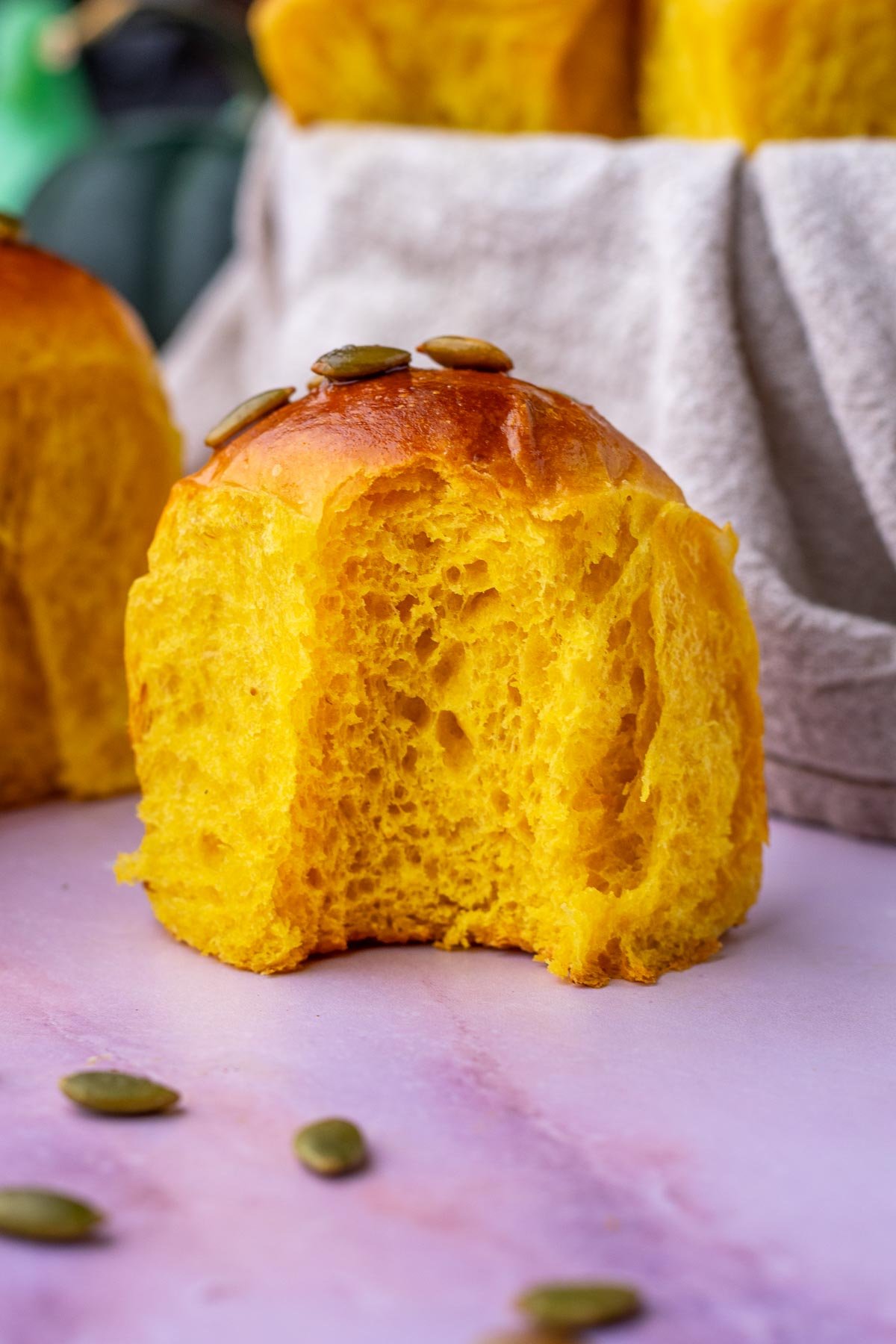

❓FAQs
Can I use all-purpose flour?
You can use all-purpose flour instead of bread flour, but note that you may need to mix more and possibly add more flour to strengthen the dough.
Why is my dough sticky?
The brioche dough can be sticky at first, depending on the moisture content of your canned pumpkin and how warm your butter is. If it’s still very sticky after mixing, add a TBS of flour at a time to your dough.
Can I use sourdough discard?
Yes, you can make sourdough discard pumpkin dinner rolls. Replace the levain with 120g of sourdough discard and a teaspoon of instant yeast. Proofing times will be faster, but otherwise, follow the same recipe.
Can I add cinnamon or pumpkin spice to the dough?
Cinnamon, like garlic, has anti-fungal properties that can inhibit fermentation so I don’t recommend adding cinnamon to these rolls. Brush the tops and serve with cinnamon honey butter instead.
What are other favorite sourdough pumpkin recipes?


Did you make this recipe?
⭐️⭐️⭐️⭐️⭐️
Please leave a rating, comment or question below! Tag me on Instagram or Facebook @SourdoughBrandon or PIN this recipe on Pinterest to come back to it later!
Sourdough Pumpkin Dinner Rolls
Perfect for Thanksgiving, these soft Sourdough Pumpkin Dinner Rolls are made with a pillowy brioche dough, sweetened with honey, and topped with pumpkin seeds.
Yield or Serving: 16 rolls
Sourdough Pumpkin Dinner Rolls
- 120 grams Whole Milk, ½ cup, scalded and cooled
- 183 grams Pumpkin Puree, ¾ cup, I use Libby’s
- 1 Egg
- Levain, or 120g active sourdough starter
- 500 grams Bread Flour, 4 cups
- 50 grams Honey, 2 ½ TBS
- 10 grams Kosher Salt
- 85 grams Unsalted Butter, 6 TBS, softened
- 1 Egg, for egg wash
- Pumpkin Seeds, optional for topping
Prevent your screen from going dark
-
Build the LevainIn a clean jar, mix the sourdough starter, bread flour, and water.Cover and set in a warm location (between 75-80ºF) for about five hours until it is at least doubled and bubbly.Alternatively, skip this step and mix 120g of active sourdough starter into your dough.
40 grams Sourdough Starter, 40 grams Bread Flour, 40 grams Water
-
Mix the DoughScald the milk in a small saucepan until just about boiling, remove from the heat, and let it cool to just warm or room temperature.Add the bread flour and salt to the bowl of a stand mixer fitted with the dough hook attachment.Then, add the pumpkin puree, honey, cooled milk, egg, and all of levain to the bowl.Mix on low speed for a few minutes until the flour is incorporated and the dough comes together.
120 grams Whole Milk, 183 grams Pumpkin Puree, 1 Egg, Levain, 500 grams Bread Flour, 50 grams Honey, 10 grams Kosher Salt
-
Add the Butter and MixSlice the room-temperature butter into pieces and while continuing to mix the dough on medium speed, add one piece of softened butter to the bowl at a time until each piece is fully incorporated into the dough.Continue to mix the dough for 10-15 more minutes until the dough passes the windowpane test, is smooth, tacky, and easily slides off of the dough hook.
85 grams Unsalted Butter
-
Bulk FermentationTransfer the dough to a medium bowl, cover, and place it in a warm location for bulk fermentation. At 78ºF, bulk fermentation takes about 6 hours (longer if cooler).Bulk fermentation is complete when the dough is doubled, domed in the bowl, and smooth.
-
Overnight Proof (optional)Cover the bowl and place it into a refrigerator to proof overnight and up to 48 hours.
-
ShapeButter or grease your 9″ square baking pan and set aside.Punch down the cold dough and weigh the total amount and divide that number by 16. This is how much each roll should weigh (mine are usually about 70g each).Use a bench scraper to divide the dough into 16 pieces. Then, use the palm of your hand to shape them into round spheres.
-
Final ProofPlace the 16 dinner rolls in the greased pan and cover for the final proof.At 78ºF, the final proof takes about 3.5-4 hours. The rolls are finished proofing when they’re doubled in size and puffy. If you poke the rolls with a floured finger, it should leave a slight indentation and feel full of air.
-
BakePreheat the oven to 375ºF (191ºC).Beat an egg with a splash of water in a small bowl and brush the tops with egg wash. Sprinkle optional pumpkin seeds on top.Bake for 25-28 minutes or until the tops are deep golden brown and the internal dough temperature reads 200ºF (93ºC). Cover with foil if they’re browning too quickly.While they bake, mix the honey and melted butter together in a small bowl. Brush the tops of the rolls with the honey butter glaze when they come out of the oven while hot.Cool on a wire rack for 15 minutes, then turn them out of the pan to finish cooling on a wire rack before serving.
1 Egg, 28 grams Unsalted Butter, 21 grams Honey, Pumpkin Seeds
- View the guide above for more detailed instructions, including photos of each recipe step, FAQs, storage, make-ahead options, and baking tips.
- Try to keep the dough at a constant, warm temperature (between 75-80ºF) as much as possible throughout fermentation. I use the Brød and Taylor bread proofer to keep my dough at a constant 78ºF. If your dough and environment are cooler, bulk fermentation will take longer. Conversely, in warmer conditions, the dough will ferment faster.




